Home >Backend Development >PHP Tutorial >Detailed explanation of PHP execution principles and processes
Detailed explanation of PHP execution principles and processes
- 不言Original
- 2018-04-20 10:49:281666browse
The content of this article is about a detailed explanation of the execution principles and processes of PHP. It has a certain reference value. Now I share it with you. Friends in need can refer to it
Introduction
Let’s take a look at the following process first:
• We have never manually started the PHP related process, it runs when Apache is started;
• PHP passes mod_php5. The so module is connected to Apache (specifically, SAPI, Server Application Programming Interface);
• PHP has three modules in total: kernel, Zend engine, and extension layer;
• PHP core is used to process requests, File streams, error handling and other related operations;
• Zend engine (ZE) is used to convert source files into machine language and then run it on a virtual machine;
• The extension layer is a set of functions, class libraries and Streams, PHP uses them to perform some specific operations. For example, we need the mysql extension to connect to the MySQL database;
• When ZE executes the program, it may need to connect to several extensions. At this time, ZE hands over the control to the extension and returns it after processing the specific task;
• Finally, ZE returns the program running results to the PHP kernel, which then transmits the results to the SAPI layer and finally outputs them to the browser.
Discussion in depth
Wait, it’s not that simple. The above process is just a simplified version, let’s dig a little deeper to see what else is going on behind the scenes.
• After Apache starts, the PHP interpreter also starts;
• There are two steps in the PHP startup process;
• The first step is to initialize some environment variables, which will occur throughout the entire SAPI life cycle Function;
• The second step is to generate some variable settings only for the current request.
The first step of starting PHP
I don’t know what the first and second steps are? Don’t worry, we’ll discuss this in detail next. Let's look at the first and most important step first. The thing to remember is that the first step of the operation happens before any requests arrive.
• After starting Apache, the PHP interpreter will also start;
• PHP calls the MINIT method of each extension to switch these extensions to an available state. Take a look at what extensions are opened in the php.ini file;
• MINIT means "module initialization". Each module defines a set of functions, class libraries, etc. to handle other requests.
A typical MINIT method is as follows:
PHP_MINIT_FUNCTION(extension_name){
/* Initialize functions, classes etc */ }1
2
3
PHP startup step two
• When a page request occurs, the SAPI layer hands over control to the PHP layer. So PHP sets the environment variables needed to reply to this request. At the same time, it also creates a variable table to store variable names and values generated during execution.
• PHP calls the RINIT method of each module, which is "request initialization". A classic example is the RINIT of the Session module. If the Session module is enabled in php.ini, the $_SESSION variable will be initialized and the relevant content will be read in when calling RINIT of the module;
• The RINIT method can Considered as a preparation process, it will start automatically between program executions.
A typical RINIT method is as follows:
PHP_RINIT_FUNCTION(extension_name) {
/* Initialize session variables, pre-populate variables, redefine global variables etc */ }1
2
3
PHP关闭第一步
如同PHP启动一样,PHP的关闭也分两步:
• 一旦页面执行完毕(无论是执行到了文件末尾还是用exit或die函数中止),PHP就会启动清理程序。它会按顺序调用各个模块的RSHUTDOWN方法。
• RSHUTDOWN用以清除程序运行时产生的符号表,也就是对每个变量调用unset函数。
一个典型的RSHUTDOWN方法如下:
PHP_RSHUTDOWN_FUNCTION(extension_name) {
/* Do memory management, unset all variables used in the last PHP call etc */
}1
2
3
PHP关闭第二步
最后,所有的请求都已处理完毕,SAPI也准备关闭了,PHP开始执行第二步:
• PHP调用每个扩展的MSHUTDOWN方法,这是各个模块最后一次释放内存的机会。
一个典型的RSHUTDOWN方法如下:
PHP_MSHUTDOWN_FUNCTION(extension_name) {
/* Free handlers and persistent memory etc */ }1
2
3
这样,整个PHP生命周期就结束了。要注意的是,只有在服务器没有请求的情况下才会执行“启动第一步”和“关闭第二步”。
下面的是用一些图示来说明的!
PHP底层工作原理
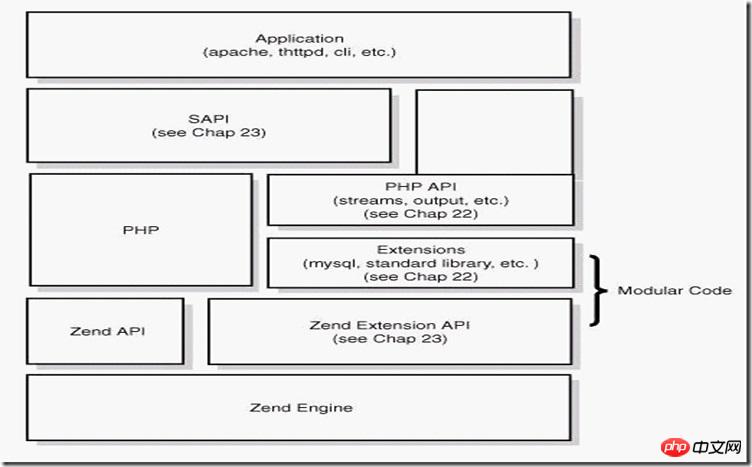
从图上可以看出,php从下到上是一个4层体系
①Zend引擎
Zend整体用纯c实现,是php的内核部分,它将php代码翻译(词法、语法解析等一系列编译过程)为可执行opcode的处理并实现相应的处理方法、实现了基本的数据结构(如hashtable、oo)、内存分配及管理、提供了相应的api方法供外部调用,是一切的核心,所有的外围功能均围绕zend实现。
②Extensions
围绕着zend引擎,extensions通过组件式的方式提供各种基础服务,我们常见的各种内置函数(如array系列)、标准库等都是通过extension来实现,用户也可以根据需要实现自己的extension以达到功能扩展、性能优化等目的(如贴吧正在使用的php中间层、富文本解析就是extension的典型应用)。
③Sapi
Sapi全称是Server Application Programming Interface,也就是服务端应用编程接口,sapi通过一系列钩子函数,使得php可以和外围交互数据,这是php非常优雅和成功的一个设计,通过sapi成功的将php本身和上层应用解耦隔离,php可以不再考虑如何针对不同应用进行兼容,而应用本身也可以针对自己的特点实现不同的处理方式。后面将在sapi章节中介绍
④上层应用
这就是我们平时编写的php程序,通过不同的sapi方式得到各种各样的应用模式,如通过webserver实现web应用、在命令行下以脚本方式运行等等。
Architectural idea:
The engine (Zend) component (ext) model reduces internal coupling
The middle layer (sapi) isolates the web server and PHP
*** *************************************************** *************
If php is a car, then
The framework of the car is php itself
Zend is the engine (engine) of the car
The various components below Ext are the wheels of the car
Sapi can be regarded as a road, and the car can run on different types of roads
And the execution of a php program means the car runs on the road.
Therefore, we need: an engine with excellent performance, a suitable wheel, a correct runway
The relationship between Apache and php
Apache’s analysis of php is through the php Module among many Modules. Completed.
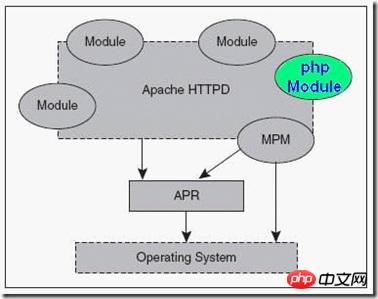
To finally integrate PHP into the Apache system, you need to make some necessary settings for Apache. Here, we will take the mod_php5 SAPI operating mode of php as an example to explain. As for the concept of SAPI, we will explain it in detail later.
Assuming that the versions we installed are Apache2 and Php5, then we need to edit Apache’s main configuration file http.conf and add the following lines to it:
In Unix/Linux environment:
LoadModule php5_module modules/ mod_php5.so
AddType application/x-httpd-php .php
Note: modules/mod_php5.so is the installation location of the mod_php5.so file in the X system environment.
In Windows environment:
LoadModule php5_module d:/php/php5apache2.dll
AddType application/x-httpd-php .php
Note: d:/php/php5apache2.dll is in Windows The installation location of the php5apache2.dll file in the environment.
These two configurations tell Apache Server that any URL user request received in the future with php as the suffix needs to be processed by calling the php5_module module (mod_php5.so/php5apache2.dll).
Apache’s life cycle
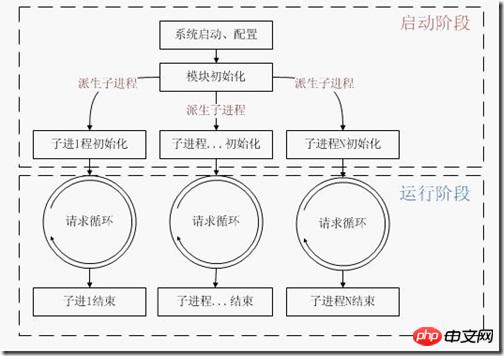
Apache’s request processing process
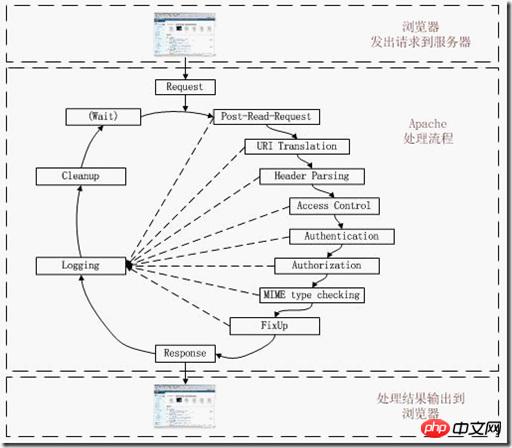
Apache request processing cycle detailed explanation
What are done in the 11 stages of the Apache request processing cycle?
1. Post-Read-Request stage
In the normal request processing process, this is the first stage where the module can insert hooks. This stage can be exploited for modules that want to get into processing requests very early.
2. URI Translation Phase
Apache’s main job in this phase is to map the requested URL to the local file system. Modules can insert hooks at this stage to execute their own mapping logic. mod_alias uses this phase to work.
3. Header Parsing Phase
The main work of Apache in this phase: Check the header of the request. Since the module can perform the task of checking request headers at any point in the request processing flow, this hook is rarely used. mod_setenvif uses this phase to work.
4. Access Control Phase
The main work of Apache in this phase is to check whether access to the requested resources is allowed according to the configuration file. Apache's standard logic implements allow and deny directives. mod_authz_host uses this phase to work.
5. Authentication stage
The main work of Apache in this stage is to authenticate users according to the policy set in the configuration file and set the user name area. Modules can insert hooks at this stage to implement an authentication method.
6. Authorization stage
The main work of Apache in this stage is to check whether authenticated users are allowed to perform the requested operation according to the configuration file. The module can insert hooks at this stage to implement a user rights management method.
7. MIME Type Checking Phase
The main work of Apache in this stage is to determine the content processing function to be used based on the relevant rules of the MIME type of the requested resource. The standard modules mod_negotiation and mod_mime implement this hook.
8. FixUp stage
This is a general stage that allows the module to run any necessary processing before the content generator. Similar to Post_Read_Request, this is a hook that can capture any information and is also the most commonly used hook.
9. Response stage
The main work of Apache in this stage is to generate content returned to the client and be responsible for sending an appropriate reply to the client. This stage is the core part of the entire process.
10. Logging stage
The main work of Apache in this stage: recording transactions after the reply has been sent to the client. Modules may modify or replace Apache's standard logging.
11. CleanUp Phase
The main work of Apache in this phase: clean up the environment left after the completion of this request transaction, such as the processing of files and directories or the closing of Socket, etc. This is processed by Apache in one request. The final stage.
LAMP Architecture
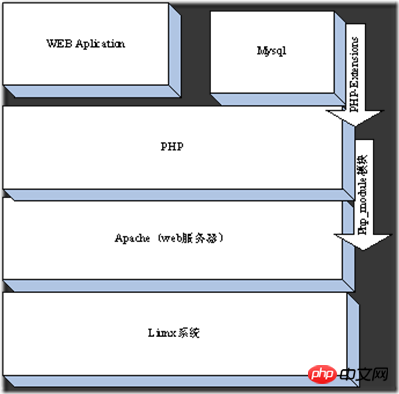
Four layers from bottom to top:
①liunx belongs to the bottom layer of the operating system
②apache server, which belongs to the secondary server and communicates linux and PHP
③php: It belongs to the server-side programming language, and is associated with apache through the php_module module. :
Detailed graphic code explanation of php’s execution principle and process
The above is the detailed content of Detailed explanation of PHP execution principles and processes. For more information, please follow other related articles on the PHP Chinese website!

